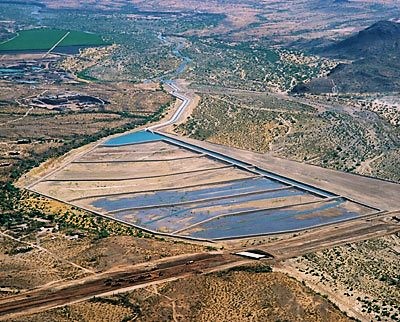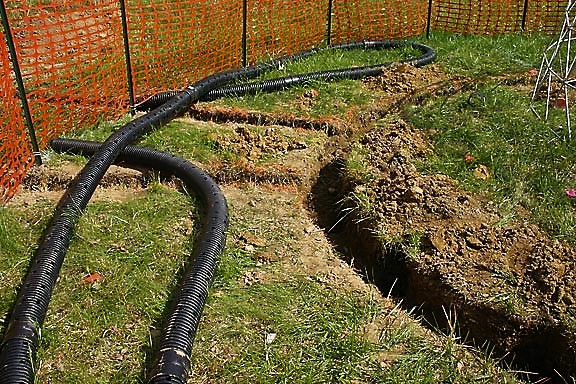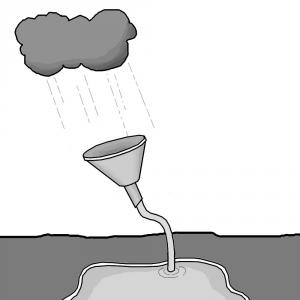المُلخص التنفيذي
Artificial recharge is the planned, man-made increase of groundwater levels. By improving its natural replenishment capacities and percolation from surface waters into aquifers, the amount of groundwater available for abstraction is increased. Treated effluent and/or stormwater is discharged into aquifers either directly or after pre-treatment (e.g. wastewater stabilisation ponds or constructed wetlands). This is particularly useful in areas where water and groundwater resources are heavily utilised and acute problems with dropping watersheds, soil salinisation, saltwater intrusion in coastal areas or water scarcity in general exist. Artificial surface groundwater recharge refers to different groundwater recharge techniques that release effluent from above the ground into the groundwater aquifer via soil percolation.
| المُدخلات | المُخرَجات |
|---|---|
Freshwater |
Introduction
Artificial groundwater recharge is the planned infiltration of effluents from sanitation systems (e.g. wastewater stabilisation ponds, surface, horizontal flow or vertical flow constructed wetlands), storm water or surface runoff into the aquifer in order to increase the natural replenishment of groundwater resources. Artificial surface groundwater recharge refers to different groundwater recharge techniques that release effluent from above the ground into the groundwater aquifer via soil percolation. Groundwater recharge is increasing in popularity as groundwater resources are being depleted and saltwater intrusion is becoming a greater threat to coastal communities (TILLEY et al. 2008).
Although the primary objective of this technology is to preserve or increase groundwater resources, artificial recharge has been used for many other beneficial purposes. These include additional treatment (through soil filtration) and conservation or disposal of treated wastewater or floodwaters, control of saltwater intrusion, storage of water to reduce pumping and piping costs as well as temporary regulation of groundwater abstraction. Furthermore water quality can be improved through the removal of suspended solids via soil filtration (see also soil aquifer treatment) or through the dilution with naturally occurring groundwater (ASANO 1985). Moreover, artificial recharge is used in waste treatment, secondary oil recovery, prevention of land subsidence, storage of freshwater within saline aquifers, crop development and stream flow augmentation (OAKSFORD 1985; UNEP 1998).
Basic Design Principles
A contaminated aquifer (e.g. by toxic chemicals) is next to impossible to recover. Therefore heavily polluted wastewater should be treated before surface groundwater recharge, even though the method provides some soil filtration treatment during percolation.
For surface groundwater recharge the assimilation capacity of the receiving soil body and the hydro geological conditions must be studied carefully. The following basic factors should be considered in particular (UNEP 1998):
- Location of geologic and hydraulic boundaries
- Depth of the aquifer and transmissivity of the overlying material
- Lithology
- Storage capacity
- Porosity
- Hydraulic conductivity and natural in- and outflow of water to/from the aquifer
- Availability of land, surrounding land use and topography
- Economic and legal aspects concerning the recharge
- Degree of public acceptance
To avoid chemical reactions that would reduce aquifer porosity and recharge capacity, the recharge water must be chemically compatible with the naturally occurring groundwater and the aquifer material that it flows through.
During operation, the quality (turbidity from sediments but also algae and bacteria, temperature, suspended solids, BOD, nitrogen and phosphorus, other chemicals, etc.) and quantity of the water to be recharged must be carefully controlled and monitored.
Surface Groundwater Recharge Methods
A variety of methods have been developed and applied to artificially recharge groundwater reservoirs in various parts of the world. Generally these methods are classified as surface and subsurface groundwater recharge.
Direct surface recharge techniques are among the simplest and most widely applied methods. Subsurface groundwater recharge conveys water directly into an aquifer without the filtration or oxidation that occurs when water percolates naturally through an unsaturated zone (UNEP 1998).
Direct Surface Groundwater Recharge
With direct groundwater recharge water moves from storage above ground to the aquifer via soil percolation. Most of the existing large-scale artificial recharge schemes in Western countries make use of this technique,which typically employs infiltration basins (spreading basins) to enhance the natural percolation of water into the ground. Field studies of spreading techniques have shown that, of the many factors governing the amount of water that will enter the aquifer, the area of recharge and length of time that water is in contact with soil are the most important (TODD 1980). In general direct surface recharge systems based on percolation have relatively low construction costs and are easy to operate and maintain.
Spreading Basins

This method involves surface spreading of water in basins that are excavated in the existing terrain. For effective artificial recharge, highly permeable soils are required and maintenance of the water layer above the soil surface is necessary. Recharge in spreading basins is most effective where there are no impending layers between the land surface and the aquifer and where clear water is available for recharge. In addition this method tolerates more turbid water than any well recharge methods does (O'HARE et al. 1986).
Recharge Pits and Shafts

Shafts can have circular, rectangular, or square cross sections and may be backfilled with porous material enhancing the percolation process and preventing the stagnation of the water (which can lead to insect breading). The shaft may end above the water table or reach below the water table and serve as hydraulic connector (O'HARE et al. 1986).
Ditches
Ditches are similar to spreading basins but they have a different shape. A ditch can be described as a long narrow trench, its bottom width being less than its depth. A ditch system can be designed to suit the topographic and geologic conditions that exist at a given site (O'HARE et al. 1986). Water fills up in the ditches and percolates naturally through the soil.
Other Recharge Techniques
Another method of artificially recharging groundwater is to use permeable pavements,which allows water surface runoff (e.g. storm water) to trickle underground, rather than allowing it to pool on the surface and evaporate (SMITH 2003).
Flood irrigation of surface water applied to surrounding farmlands is also a vital source of groundwater recharge. As agricultural land is converted to urban use, identifying sites for additional groundwater recharge is essential to keep water supplies balanced (water consumption of urban areas are generally lower, but impact of deep percolation from flood irrigation is lost; FRESNO 2005).
Groundwater recharge methods are particularly useful in areas with aquifers with long retention times, where water and groundwater resources are heavily utilised and acute problems with dropping watersheds, soil salinisation, saltwater intrusion in coastal areas or water scarcity in general exist.
The effectiveness of discharge into an aquifer will depend entirely on the quality and quantity of the water to be infiltrated, local environmental conditions (e.g. hydraulic conductivity, nutrient assimilation capacity of the receiving soil body) and legal regulations.
While surface injection methods require relatively flat or gently sloped lands, topography has little effect on subsurface recharge methods. Aquifers best suited for artificial recharge are those that can absorb and retain large quantities of water. In temperate humid climates the following alluvial areas are best suited for artificial recharge: areas of ancient alluvium, buried fossil riverbeds and alluvial fans interlinked by main valley and tributaries.In arid zones, recent river alluvium may be more suitable. Coastal dunes and deltaic areas are also often very favourable areas for artificial recharge schemes (UNEP 1998).
The physical, chemical and biological quality of recharge water also affects the selection of the recharge method. If suspended solids are present, surface application techniques tend to be more efficient than sub-surface techniques that can result in clogging of injection wells. Water containing toxic chemicals or chemicals that could reduce aquifer porosity or recharge capacity must be pre-treated if used for artificial groundwater recharge.
Cultural considerations and socio-economic concerns often affect the selection of a recharge method and site. The availability of land, land uses in adjacent areas, public attitude and legal requirements generally play a role in defining the acceptability of artificial recharge in a given setting. In urban areas, where land availability, costs and uses in adjacent areas may impose restrictions, injection wells, shafts or small pits requiring highly controlled water supplies and little land area may be preferable to larger scale, surface spreading recharge methods. Surface recharge facilities generally require protected property boundaries, regular maintenance and continuous surveillance if they are to be accepted by the public.
Artificial Recharge of Groundwater
Drainage Ditches Flanking the Path into and out of Wholeo Dome
Typical spreading basin
Fresno Area Regional Groundwater Management Plan
Artificial Recharge: Methods, Hydraulics, and Monitoring
What is Groundwater Recharge?
Compendium of Sanitation Systems and Technologies
This compendium gives a systematic overview on different sanitation systems and technologies and describes a wide range of available low-cost sanitation technologies.
TILLEY, E., LUETHI, C., MOREL, A., ZURBRUEGG, C. and SCHERTENLEIB, R. (2008): Compendium of Sanitation Systems and Technologies. Duebendorf, Switzerland: Swiss Federal Institute of Aquatic Science and Technology (EAWAG) and Water Supply and Sanitation Collaborative Council (WSSCC) URL [Accessed: 15.02.2010] PDFGroundwater Hydrology. Second Edition
Sourcebook of Alternative Technologies for Freshwater Augmentation in Some Countries in Asia (Technical Publication)
The Artificial Recharge of Groundwater
Recharge Of Groundwater
Groundwater recharge with recycled municipal wastewater: Criteria for health related guidelines
This article aims to highlight some principles related to aquifer recharge with recycled water, and to propose a simple approach to health related guidelines that take into account existing water regulations and guidelines.
BRISSAUD, F. (1999): Groundwater recharge with recycled municipal wastewater: Criteria for health related guidelines. France: Hydrosciences, MSE, Univ. Montpellier II, 34095 Montpellier Cedex 05Artificial Recharge and Rainwater Harvesting
Innovations in Groundwater Recharge. Water Policy Briefing. IWMI-TATA Water Policy Program
This brochure gives an overview on different low-cost aquifer recharge solutions based on the results from a 10-year pilot project in Uttar Pradesh. It indicates a practical and low-cost way to conserve and rejuvenate falling groundwater reserves.
IWMI (2002): Innovations in Groundwater Recharge. Water Policy Briefing. IWMI-TATA Water Policy Program. Vallabh Vidyanagar: International Water Management Institute URL [Accessed: 21.03.2019]Guide on Artificial Recharge to Groundwater
This document provides guidance on artificial recharge techniques and designs and the planning and monitoring of artificial recharge projects.
MINISTRY OF WATER RESOURCES (2000): Guide on Artificial Recharge to Groundwater. New Delhi: Central Ground Water Board URL [Accessed: 21.03.2019]Small Community Water Supplies: Technology, People and Partnership: Artificial Recharge - Chapter 6
This book provides a general introduction to a wide range of technologies. Among the topics covered are: planning and management of small water supplies, community water supplies in Central and Eastern European countries, water quality and quantity, integrated water resources management, artificial recharge, rainwater harvesting, spring water tapping, groundwater withdrawal, water lifting, surface water intake, water treatment, aeration, coagulation and flocculation, sedimentation, multi-stage filtration, desalination technology, disinfection, household level water treatment, technologies for arsenic and iron removal from ground water, and emergency and disaster water supply. Chapter 6: Artificial Recharge
SMET, J. ; WIJK, C. van (2002): Small Community Water Supplies: Technology, People and Partnership: Artificial Recharge - Chapter 6. The Hague: International Water and Sanitation Centre (IRC) URL [Accessed: 21.03.2019]Management of aquifer recharge and discharge processes and aquifer storage equilibrium
This paper draws attention to case studies from a range of hydro-geological, climatic and societal settings where innovative management has been successful in reversing groundwater storage declines (or increases). Informing and engaging stakeholders in governance has resulted in more resilient outcomes that take better account of local needs. Importantly, in many settings local action by motivated communities has run ahead of state and national policies and been highly effective in managing groundwater storage, increasing farm incomes and protecting the environment.
FAO GEF IAH IHP World Bank (2012): Management of aquifer recharge and discharge processes and aquifer storage equilibrium. Food and Agriculture Organization (FAO) URL [Accessed: 08.04.2013]Water Harvesting
Water harvesting has been practiced successfully for millennia in parts of the world – and some recent interventions have also had significant local impact. Yet water harvesting’s potential remains largely unknown, unacknowledged and unappreciated. These guidelines cover a wide span of technologies from large-scale floodwater spreading to practices that collect and store water from household compounds.
MEKDASCHI STUDER, R. LINIGER, H. (2013): Water Harvesting. Guidelines to Good Practice. Bern/Amsterdam/Wageningen/Rome: Centre for Development and Environment (CDE), Rainwater Harvesting Implementation Network (RAIN), MetaMeta, The International Fund for Agricultural Development (IFAD) URL [Accessed: 12.03.2019] PDFGroundwater recharge with recycled municipal wastewater: health and regulatory considerations
This case study on groundwater recharge with recycled wastewater focuses on quantifying possible health implications.
ASANO, T. COTRUVO, J. (2004): Groundwater recharge with recycled municipal wastewater: health and regulatory considerations. Davis: Department of Civil and Environmental Engineering, University of California URL [Accessed: 15.04.2011]Water and Community Development. Rainwater harvesting and groundwater recharge. A sustainable approach to human development at the global level
Article on rainwater harvesting and groundwater recharge in India and other countries.
DAVIES, R. ROY, B. (2004): Water and Community Development. Rainwater harvesting and groundwater recharge. A sustainable approach to human development at the global level. London: International Business Leaders Forum URL [Accessed: 22.03.2019] PDF
